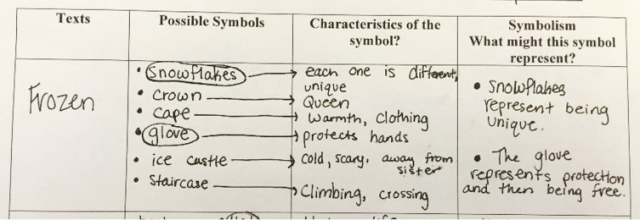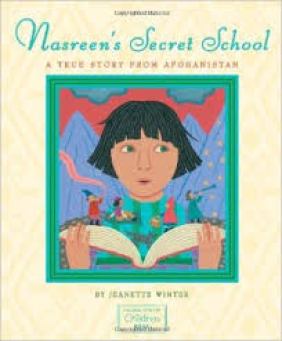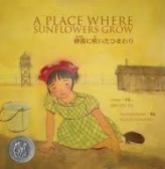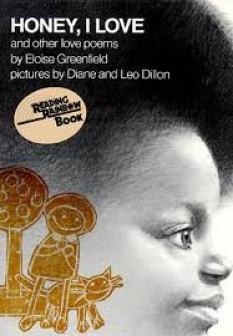Still frozen? Wow, we got a lot of snow this week! Sonja got 20 inches and Dana got 15! With all that snow, why not embrace an old classic- “Let it Go!” This song, popular in 2013, was a huge hit with students. Why not use this well-known song to teach symbolism? Students of all ages can do this rigorous work with a digital text like “Let it Go!” Similar to our post about using the commercial with the miniature horse, students can engage with this digital text in a new way. They can read through the lens of symbolism.
Symbolism– “Let it Go!” is incredible for teaching symbolism! Try these 3 exercises with your students:
Strategy #1- Read the text with purpose. Ask your students to notice important objects that are meaningful to the character while watching the clip. (Glove, crown, staircase, snowflakes, cape etc.)
Strategy #2- Have students think about these objects. What is the function of a glove, a cape, a crown, a staircase? (Protection, royalty, a climb?)
Strategy #3- Ask your students about these objects and what they might symbolize. Think about their function first and then discuss what it might symbolize. For example, a staircase might symbolize a climb or journey: the crossing from one place to another. How might this relate to Elsa’s situation?
In the work sample below, you can see that the student is thinking about the objects in the clip. Next, she thinks about their characteristics. Last, she considers what they might represent. We’ve found great success using this digital text and graphic organizer with our students to teach symbolism. Let us know your thoughts.

Originally from Pennsylvania, Dana Johansen is hoping that Punxsutawney Phil will not see his shadow on Feb. 2 and there will be an early spring. In the meantime, she spends her time teaching fifth grade in wintery Connecticut, sitting with her yellow lab on the couch reading YA Lit, and watching the tv show, The Big Bang Theory. She has taught elementary and middle school for fourteen years. Dana is a doctoral student at Teachers College, Columbia University where she studies blended learning in reading and writing workshop. She is the co-author of the books Teaching Interpretation and Flip Your Writing Workshop.
Sonja Cherry-Paul is a member of the Jane Addams Children’s Book Award Committee. She has been immersed in reading wonderful books created by authors and illustrators who address themes related to social justice. The best part of this process is sharing these incredible books with her 6th graders and the insightful conversations they spark. She is co-author of Teaching Interpretation: Using Text-Based Evidence to Construct Meaning and Flip Your Writing Workshop: A Blended Learning Approach.


































 At this point in the school year, my classroom library needs a little sprucing up. Without making major changes, I want to make a some changes. My hope is that these changes will make the library inviting, cheerful, and enticing for my young readers. I love those makeover shows when they show the BEFORE and AFTER pictures, so I thought it would be fun if I did the same thing in this post.
At this point in the school year, my classroom library needs a little sprucing up. Without making major changes, I want to make a some changes. My hope is that these changes will make the library inviting, cheerful, and enticing for my young readers. I love those makeover shows when they show the BEFORE and AFTER pictures, so I thought it would be fun if I did the same thing in this post. 1. “Move the Bins”- Do you ever go into the grocery store or Target and they’ve changed where everything is? Aisle 10 now holds all the products from Aisle 3? Or the shoe department is now located where the sporting goods used to be? Stores do this so their customers have to switch it up and change their shopping routines. They must take a new route and explore new parts of the store. I applied this shopping strategy to my library. I switched the locations of the bins. For example, I switched the mystery book bins with fantasy fiction book bins. I also tidied up the bins. (This took about 8 mins and my trusty desk wheely chair.)
1. “Move the Bins”- Do you ever go into the grocery store or Target and they’ve changed where everything is? Aisle 10 now holds all the products from Aisle 3? Or the shoe department is now located where the sporting goods used to be? Stores do this so their customers have to switch it up and change their shopping routines. They must take a new route and explore new parts of the store. I applied this shopping strategy to my library. I switched the locations of the bins. For example, I switched the mystery book bins with fantasy fiction book bins. I also tidied up the bins. (This took about 8 mins and my trusty desk wheely chair.)


 Picture books are for all ages. However, there is great debate among educators about the role of picture books in the classroom, especially in upper elementary grades, middle school and high school.
Picture books are for all ages. However, there is great debate among educators about the role of picture books in the classroom, especially in upper elementary grades, middle school and high school.